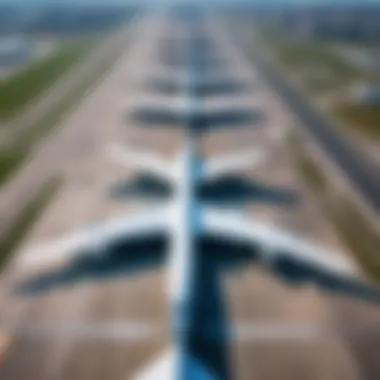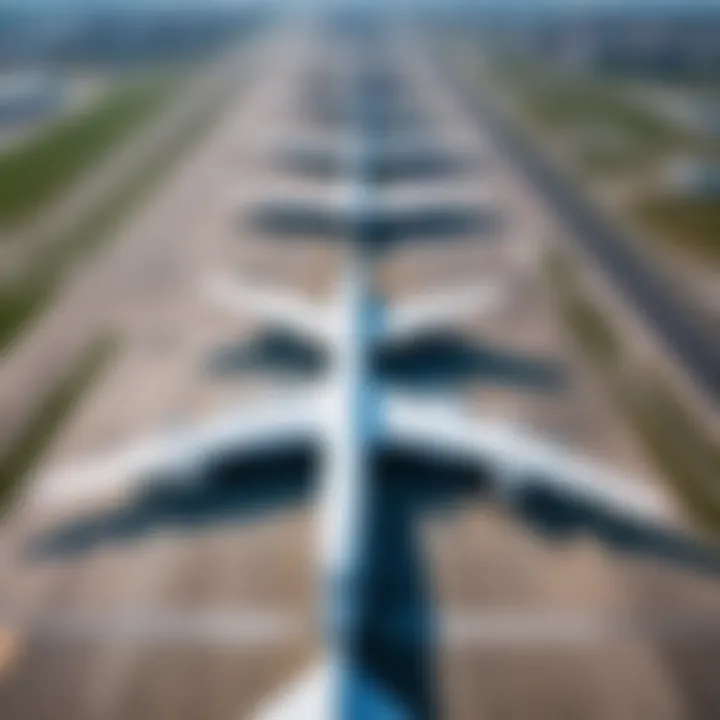Airports of Russia: A Comprehensive Overview


Intro
The aviation landscape in Russia is vast and intricate, shaped by years of historical evolution and economic development. Airports serve as pivotal junctions for both international and domestic travel. This article presents a thorough examination of Russia's airports, exploring their significance not only as transport hubs but also as central players in fostering tourism and stimulating the economy.
In this overview, we will highlight notable airports across various regions, analyze the current operational standards, and delve into the challenges confronted by the aviation sector. Moreover, this piece will touch on future trends influencing air travel in the country, providing valuable insight for seasoned travelers and newcomers alike.
Популярные направления
Russia’s geographical expanse offers a plethora of travel options for both leisure and business. Noteworthy destinations include cosmopolitan cities like Moscow and St. Petersburg, known for their rich cultural heritage, as well as natural wonders such as Lake Baikal and the Kamchatka Peninsula.
- Unique Destinations for Exotic Travel
Travelers seeking distinct experiences often gravitate towards lesser-known airports that unlock unique regions. For instance:
- Ulan-Ude Airport (UUD): Close to the beautiful Lake Baikal, renowned for its biodiversity.
- Petropavlovsk-Kamchatsky Airport (PKC): The gateway to the stunning landscapes of Kamchatka.
These airports not only serve as transit points but also as starting grounds for captivating adventures.
- Comfortable Spots for Family Leisure
Airports that cater to family needs often provide facilities that enhance the travel experience. For instance:
- Domodedovo International Airport (DME) in Moscow features a varied selection of eateries and children's play areas, making layovers more enjoyable.
- Pulkovo Airport (LED) in St. Petersburg provides family lounges and kid-friendly amenities, ensuring a stress-free transition.
These family-friendly facilities are crucial for making travel with children less daunting, allowing families to focus on the journey rather than the logistics.
Подготовка к путешествию
Understanding how to prepare for air travel can significantly influence the overall experience. From planning the travel route to efficient packing, effective preparation can streamline the journey.
- Tips for Choosing Travel Routes
- How to Pack a Suitcase: Useful Advice
Packing can be a tedious process, but some strategies can ease the burden:
- Research flight options: Use multiple platforms to compare prices and timings, including Skyscanner or Google Flights.
- Consider stopovers: Sometimes, flights with layovers can be cheaper and may also give a chance to explore another city.
- Check for visa requirements: Ensure all necessary travel documentation is in order before booking tickets.
- Roll clothes to save space and reduce wrinkles.
- Use packing cubes for organization and accessibility.
- Make a checklist to ensure essential items are not forgotten.
Proper preparation sets the tone for a successful journey, contributing to a more enjoyable travel experience.
By understanding the importance of airports in Russia and how to navigate them, travelers can make informed decisions for their trips. The intricate network of airports not only connects various regions but also enhances the overall travel experience, ensuring that adventures within the expansive and diverse landscapes of Russia are memorable.
Prologue to Russian Airports
Airports play a critical role in the transportation network of Russia, a vast country that spans eleven time zones. The significance of these airports extends beyond mere connectivity; they are gateways to both international travel and domestic exploration. Understanding the airports of Russia helps to unpack their historical evolution, current operational realities, and their influence on the economy and tourism. The modern landscape of Russian airports reflects the balance between heritage and innovation within the aviation sector.
Historical Context
Russian airports have a rich and intricate history that traces back to the early days of aviation. The establishment of the first commercial airport in Russia occurred in the 1920s. By the mid-20th century, airports became hubs for military and civilian operations, especially during the Cold War.
As air travel began to democratize in the late 20th century, many airports underwent significant expansion and modernization. The dissolution of the Soviet Union in 1991 brought about a gradual shift towards greater international cooperation in air travel, allowing for more foreign airlines to operate in the country. The development of facilities like Sheremetyevo International Airport and Domodedovo International Airport reflects this transformation, catering to increased passenger demands and shifting dynamics in global travel.
Current Landscape
Today, Russia boasts a diversified array of airports that serve a multitude of functions. The current landscape involves major international airports such as Sheremetyevo, Domodedovo, and Vnukovo, alongside numerous regional airports that facilitate travel throughout the expansive Russian territory.


Modernization efforts are ongoing, aiming to enhance passenger experience and operational efficiency. Airports are now equipped with advanced technology to streamline check-in processes and ensure security. Additionally, many airports prioritize passenger comfort, offering facilities like lounges, dining options, and duty-free shopping.
In terms of passenger volume, Moscow's airports are among the busiest in Europe, reflecting Russia's role as a crucial connection point between Europe and Asia. The rise of low-cost airlines and increased air traffic has intensified the competition among airports, pushing them to improve their services constantly.
"The evolution of Russian airports symbolizes the broader changes within the country's aviation industry, showcasing adaptability in a rapidly changing global landscape."
In summary, understanding the historical and current contexts of Russian airports provides valuable insights into their operational significance and future potential. As they continue to develop and respond to market demands, these airports will play a pivotal role in shaping travel in Russia and beyond.
Major Airports in Russia
The significance of major airports in Russia cannot be overstated. They serve as critical hubs for domestic and international travel, facilitating not just passenger movement but also cargo transportation. The operational standards and infrastructure of these airports often reflect the broader developments in the aviation sector. Major airports significantly contribute to the economy of their respective regions, offering employment opportunities and acting as gateways for tourism. Their roles can also affect connectivity to remote areas, enhancing regional development.
Sheremetyevo International Airport
Sheremetyevo International Airport, located in Moscow, is one of the busiest airports in Russia. It serves as a primary hub for international flights and connects the capital to numerous destinations around the globe. The airport, often referred to simply as SVO, has undergone extensive modernization in recent years.
Travelers appreciate the array of services available at Sheremetyevo. These include modern lounges, duty-free shopping, and a variety of dining options that reflect both international and local cuisine. The convenience of transportation to the city center is another benefit, with express trains and available taxis.
Domodedovo International Airport
Another key player in the Russian aviation landscape is Domodedovo International Airport. This airport, signalised as DME, is also situated in the Moscow area. It ranks as one of the major airports in terms of passenger traffic, particularly for international flights. Domodedovo has been noted for its emphasis on passenger comfort and efficient operations.
The airport features spacious terminals and offers various amenities such as business centers and shops. It has continually worked to improve its services, making it a preferred choice for many travelers. The airport’s management has invested in technology to streamline check-ins and enhance the overall travel experience.
Vnukovo International Airport
Vnukovo International Airport, designated as VKO, is another prominent airport in Moscow. It boasts historical significance as the oldest operating airport in the city. Vnukovo has a diverse flight offering, catering to both domestic and international routes.
Vnukovo is smaller and often less crowded than Sheremetyevo and Domodedovo. This makes it attractive for travelers who prefer a more tranquil airport experience. The facilities remain modern and efficient, providing a comfortable experience for passengers.
Regional Airports
Beyond the major Moscow airports, Russia has a network of regional airports that play crucial roles in connecting the vast country. Airports such as Pulkovo International Airport in Saint Petersburg and Koltsovo International Airport in Yekaterinburg facilitate the movement of people and goods across regions.
These airports often serve as critical links for tourists and locals alike, connecting them to larger hubs or international routes. The regional airports have been developing more amenities and services to cater to rising passenger numbers.
Airport Infrastructure Development
The development of airport infrastructure plays a crucial role in the aviation sector of Russia. With a vast land area and diverse geography, the country's airports are not just transit points; they are integral to connecting different regions and promoting economic growth. A well-structured airport network facilitates not only domestic travel but also international connections, fostering tourism, trade, and cultural exchange.
Modernization Efforts
Modernization of airports in Russia is an ongoing process aimed at enhancing operational efficiency and passenger experience. Many airports are undergoing renovations to meet international standards. This includes upgrading runways, terminals, and navigational systems. Notable efforts are seen at Sheremetyevo International Airport and Domodedovo International Airport, where significant investments have been made to expand facilities and improve services.
These upgrades are not merely cosmetic but focus on integrating advanced technology. For example, streamlined check-in processes and self-service kiosks have been introduced, reducing wait times for travelers. Enhanced digital signage and real-time data displays also improve the flow of passenger information, creating a more user-friendly environment. Such modernization efforts are essential to accommodate the growing number of air travelers in Russia.
Furthermore, airports are adopting smart technologies to enhance security protocols without hampering convenience. This not only helps in better resource management but also increases overall safety in air travel.
Sustainability Initiatives


Sustainability in airport operations is becoming an imperative factor in Russia. Airports are implementing green initiatives aimed at reducing their carbon footprint. From energy-efficient terminal designs to waste management programs, the focus is shifting towards environmentally friendly practices.
For instance, the installation of solar panels and use of energy-efficient lighting systems at airports contribute significantly to energy conservation. Additionally, many airports are exploring ways to use sustainable aviation fuel (SAF) and improve their ground transportation systems, which results in lower emissions.
Airports such as Pulkovo and Vnukovo have initiated programs to promote recycling and reduce plastic waste. These sustainability initiatives align with global trends in aviation and respond to growing public awareness regarding climate change. Embracing these practices not only helps to protect the environment but also enhances the reputation of airports as responsible entities in the aviation sector.
"Investing in airport infrastructure modernization and sustainability is crucial for not just improving air travel but also securing the ecological future of aviation."
In summary, the development of airport infrastructure in Russia reflects a commitment to modernity and environmental responsibility. Continuous modernization efforts and a focus on sustainability are vital aspects that will determine the longevity and efficiency of Russian airports in the global aviation landscape.
Airports and Tourism
The link between airports and tourism is significant, as airports are not just gateways to travel but also act as catalysts for economic activity and cultural exchange. Airports in Russia play a critical role in shaping the tourism landscape of various regions. Through their operations, they facilitate the movement of millions of travelers, thus supporting local economies and creating jobs.
Airports are essential for tourism development, influencing travel patterns and accessibility.
Efficient airport services can enhance the overall travel experience. They ensure that tourists have smooth arrivals and departures, which is crucial for encouraging return visits. Also, the presence of major international and regional airports often attracts a variety of airlines, increasing flight options. This leads to competitive pricing and better travel packages, making it easier for tourists to explore Russia.
Economic Impact
The economic impact of airports on tourism can be measured in several dimensions. First, airports generate direct income through landing fees, cargo movement, and passenger service charges. This income supports the airport's operational costs and development projects.
Indirectly, airports stimulate local economies by creating jobs. Jobs in hospitality, transportation, and retail sectors often depend on the traffic that airports bring. As such, a busy airport can trigger a chain reaction of job creation across various industries. Furthermore, tourism generates significant tax revenue for local and regional governments. This revenue can then be reinvested into public services and infrastructure.
Moreover, airports facilitate foreign direct investment in the tourism sector. Areas around airports see increased investment in hotels, restaurants, and leisure activities. This investment boosts the economy and provides visitors with more options during their stay.
Tourism Growth
Tourism growth in Russia is inextricably linked to its airports. An increase in passenger traffic is often paralleled by the growth of tourism attractions within the vicinity. Popular destinations near major airports like Sheremetyevo or Domodedovo often see a surge in visitors during peak travel seasons.
Additionally, airports help promote domestic tourism. Efficient internal flights connect major cities like Moscow and St. Petersburg with far-flung regions such as Kamchatka or the Russian North. This accessibility provides Russians with opportunities to explore diverse landscapes and cultures within their own country.
As tourism grows, the emphasis on enhancing airport facilities and services becomes more pronounced. With technology advancements, airports are increasingly adopting digital solutions to streamline operations and improve customer experiences. Such innovations will likely lead to even greater tourism growth in the future.
In summary, airports serve as a crucial backbone to the tourism sector in Russia. By understanding this relationship, stakeholders can better harness the potential of airports to foster tourism growth and overall economic development.
Safety and Regulations
The aviation sector operates within an intricate framework of safety and regulations. In Russia, this framework ensures that both passengers and cargo are transported efficiently and securely. Safety standards are not solely about compliance; they also foster public trust and enhance the overall travel experience. As air travel grows, effective regulations become even more crucial, addressing safety management systems, risk assessments, and incident reporting.
Security Standards
At the forefront of airport safety are security standards. In Russia, these are defined by national and international guidelines, primarily influenced by the International Civil Aviation Organization. Airports employ various measures to ensure safety. This includes passenger screening, baggage checks, and surveillance technologies. The presence of trained security personnel plays a critical role as well. Each airport has its unique layout and thus implements tailored security measures based on the specific challenges it faces.
Moreover, the Russian authorities continuously revise security protocols in response to emerging threats. Recently, enhancements include the adoption of biometric technology for passenger identification. This not only speeds up the boarding process but also strengthens security at key checkpoints.
"An effective security system is vital for maintaining the integrity of air travel, ensuring that every passenger feels safe on their journey."
Health Protocols


Health protocols have gained prominence, especially in the wake of global health crises. In Russian airports, these protocols are designed to protect public health and ensure safe travel for all. During the ongoing challenges posed by health emergencies, measures such as temperature screening, regular disinfection of facilities, and mandatory face masks have been instituted.
Airports like Sheremetyevo International have implemented systems for managing health-related information. Passengers must now provide proof of vaccination or recent negative tests before boarding international flights. This not only protects individual travelers but also mitigates broader transmission risks. Advanced air filtration systems in passenger areas further ensure a healthy environment.
In summary, the balance of safety and health regulations is crucial for the integrity of air travel in Russia. Adapting to new threats, whether they be from potential security risks or health concerns, must remain a priority. Airports need to regularly evaluate and modify protocols to maintain this balance.
Challenges Facing the Aviation Sector
The aviation sector in Russia is currently grappling with several challenges that have significant implications for its operations, growth, and sustainability. Understanding these challenges is crucial not only for industry stakeholders but also for travelers and the economy at large. This section will delve into the economic constraints and geopolitical issues faced by Russian airports, which collectively influence the functionality and development of this vital transportation network.
Economic Constraints
The economic landscape significantly affects the aviation sector in Russia. Various factors contribute to the financial struggles faced by airports and airlines.
- Fluctuating Fuel Prices: The volatility in fuel prices is a major issue. Airlines must adjust their budgets accordingly, which may lead to increased ticket prices for consumers.
- Infrastructure Investments: Upgrading and maintaining airport infrastructure requires substantial investments. Delays in these upgrades can hinder an airport's ability to accommodate modern aircraft or increase traffic.
- Shrinkage of Domestic Market: Following economic sanctions and pandemic-related downtimes, the domestic market has seen a shrinkage. This decline can lead to reduced revenues for airlines, ultimately affecting service quality and frequency.
- Competition from Other Destinations: Increasingly, travelers are looking at alternative destinations. If Russian airports do not provide competitive pricing and quality services, they risk losing travelers to nearby countries.
Moreover, currency exchange rates impact international travels, making it more complex for non-Russian travelers to access Russian airports. These economic constraints necessitate strategic planning to ensure long-term sustainability and growth.
Geopolitical Issues
Geopolitical tensions play a significant role in shaping the aviation landscape in Russia. Factors include:
- International Sanctions: Ongoing sanctions against Russia have led to reduced international air traffic, limiting the options available for travelers and impacting overall airport revenues.
- Airspace Restrictions: Some countries have closed their airspace to Russian airlines, leading to longer travel times and reduced operational efficiency. Airlines must navigate complex routes that may increase costs and affect service reliability.
- Political Stability: Political unrest in neighboring countries can create hesitations for travelers. Safety perceptions are critical for people choosing to fly to or from Russia.
- Shift in Alliances: As international relations fluctuate, airlines may find it difficult to maintain partnerships. This impacts codeshare agreements and interline agreements that are essential for smooth operations.
Understanding the interrelation of these challenges is essential for addressing the issues within the aviation sector. Economic constraints and geopolitical challenges shape not only the operations of airports but also influence travel decisions for both international and domestic passengers.
These issues underline the need for proactive strategies to mitigate risks and adapt to changing circumstances. Addressing these challenges is vital for the growth and sustainability of aviation in Russia.
Future Trends in Russian Airports
The aviation industry in Russia is undergoing substantial changes as it adapts to shifting global dynamics. Future trends in Russian airports are shaped by advancements in technology and emerging market demands. Understanding these trends is crucial as they influence operational efficiency, customer experience, and the overall viability of the aviation sector.
Technological Advancements
Modern technology is revolutionizing airport operations in Russia. The integration of automation and artificial intelligence functions aims to enhance security and streamline passenger processes. Automated check-in kiosks and baggage handling systems are becoming commonplace. This reduces wait times and improves efficiency. For instance, Zhukovsky International Airport is adopting biometric systems to increase security and expedite passenger flow.
Additionally, the implementation of smart technology is crucial in airport management. Real-time data analytics help airports optimize flight schedules and manage passenger traffic, thereby reducing congestion. Moreover, advanced communication systems are facilitating better coordination between ground staff and air traffic control. These developments not only improve safety but also enhance operational resilience.
"Technological innovation is pivotal to creating a seamless travel experience for passengers, while maximizing operational performance at airports."
Market Forecasts
The future market for aviation in Russia is shaped by various factors, including economic conditions, regulatory changes, and travel trends. Experts predict a growth trajectory in passenger numbers as economic stability returns. Forecasts indicate that air travel demand will increase significantly in the coming years, particularly in the domestic travel market. Cities such as Vladivostok and Kazan are expected to see higher volumes due to increased tourism and business travel.
Additionally, international travel is predicted to rebound as global restrictions ease. Airports like Sheremetyevo and Domodedovo will likely expand their routes and services to cater to increasing passenger numbers. Compounding this is the growing desire for eco-friendly travel options. Airports are expected to invest in sustainable practices, aligning with global trends towards environmental responsibility.
Ending
In closing, this article unveils the multifaceted significance of Russian airports within the broader aviation framework. Airports play a crucial role not only in facilitating domestic and international travel but also in economic development. They serve as hubs connecting regions, stimulating both tourism and local businesses. As the world evolves, so too does the landscape of air travel, and the advancements in technology promise a more streamlined experience.
Furthermore, the discussion around sustainability and modernization initiatives captures the ongoing commitment to adapting these facilities to contemporary standards. The implications of these changes extend beyond mere logistics; they affect cultural exchanges and international relations.
"Airports are not just transit points; they are gateways to diverse experiences and opportunities."
Key Takeaways
- Importance of Connectivity: Russian airports significantly enhance connectivity within the country and with global destinations, promoting economic growth and tourism.
- Investment in Infrastructure: Continuous investment in airport infrastructure is vital for improving efficiency and passenger experience. This investment reflects broader trends in the aviation industry.
- Impact on Economy: Airports contribute to job creation and the cultivation of local economies, serving as a vital component of Russia's economic landscape.
- Emphasis on Safety: Attention to safety and compliance with international standards are paramount in maintaining traveler confidence and security.
- Future Considerations: With ongoing geopolitical and economic challenges, the future of Russian airports will depend on adaptability and innovation.







